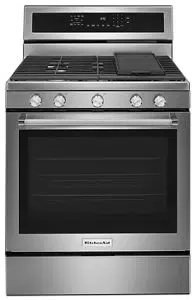Documents: Go to download!
User Manual
- User Manual - (English, French)
- Quick Start Guide - (English)
- Specification Sheet - (English)
- Installation Instructions - (English)
- DIMENSION GUIDE - (English)
- VENTILATION PAIRING GUIDE - (English)
- Warranty - (English)
- FEATURE GUIDE
- COOKTOP USE
- OVEN USE
- RANGE CARE
- TROUBLESHOOTING
Table of contents
User Manual
FEATURE GUIDE
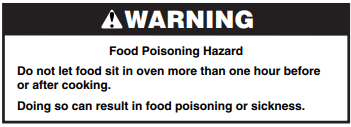

KEYPAD | FEATURE | INSTRUCTIONS |
CLOCK | Clock | This clock can use a 12 or 24 hour cycle. See “Electronic Oven Controls” section.
|
OVEN LIGHT | Oven cavity light | While the oven door is closed, press OVEN LIGHT to turn the lights on and off. The oven light will come on when the oven door is opened. |
TIMER SET/OFF | Oven timer | The Timer can be set in hours or minutes up to 9 hours and 59 minutes.
|
START | Cooking start | The Start pad begins any oven function. If Start is not pressed within 2 minutes after pressing a keypad, the function is canceled and the time of day is displayed. |
OFF | Range function | The Off keypad stops any oven function except the Clock, Timer and Control Lock. |
BAKE | Baking and roasting |
|
BROIL | Broiling |
|
| CONVECT BAKE | Convection cooking |
|
CONVECT BAKE | Convection cooking |
|
CONVECT ROAST | Convection cooking |
|
CONVECT BROIL | Convection cooking |
|
EASYCONVECT™ CONVERSION | Recipe conversion for convection cooking | NOTE: For best results, preheat your oven to the required temperature prior to using EasyConvect Conversion. After preheating is complete, press OFF before using EasyConvect Conversion.
Check food for doneness before the stop time is reached. If food will not be done when stop time is reached, add more cooking time before time elapses. See the “Cook Time” section. At the end of the stop time, the oven will automatically turn off. 6. Press OFF when finished. Refer to “EasyConvect Conversion” section for more information. |
BREAD PROOF | Proofing bread |
NOTE: “Rapid Proof” operates at a slightly higher temperature for second rise of formed dough. 2. Press START. Let the dough rise until nearly doubled in size. Proofing time may vary depending on dough type and quantity. 3. Press OFF when finished proofing. Refer to the “Proofing Bread” section for more information. |
KEEP WARM | Hold warm | Food must be at serving temperature before placing it in the warmed oven.
|
DELAY START | Delayed start | The Delay Start keypad is used to enter the starting time for an oven function with a delayed start. Delay Start should not be used for foods such as breads and cakes because they may not bake properly. To set a Cook Time or a Delayed Cook Time, see “Cook Time” section. |
COOK TIME | Cook time | Cook Time allows the oven to be set to turn on at a certain time of day, cook for a set length of time, and/or shut off automatically. To set a Cook Time or a Delayed Cook Time, see “Cook Time” section. |
CONTROL LOCK hold 3 sec. to lock | Oven control lockout | No keypads will function with the controls locked.
Repeat to unlock. |
OPTIONS | Oven use functions | Enables you to personalize the audible tones and oven operation to suit your needs. See the “Oven Use” section. |
COOKTOP USE

Electric igniters automatically light the surface burners when control knobs are turned to  .
.
Before setting a control knob, place filled cookware on the grate. Do not operate a burner using empty cookware or without cookware on the grate.
To Set:
- Push in and turn knob counterclockwise to
 . All surface burners will click. Only the burner with the control knob turned to
. All surface burners will click. Only the burner with the control knob turned to  will produce a flame.
will produce a flame. - Turn knob to anywhere between H (high) and L (low).
Power Failure
In case of prolonged power failure, the surface burners can be lit manually. Hold a lit match near a burner, and then turn knob counterclockwise to  . After burner lights, turn knob to desired setting.
. After burner lights, turn knob to desired setting.
Sealed Surface Burners
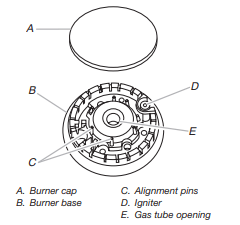
Burner cap: Always keep the burner cap in place when using a surface burner. A clean burner cap will help avoid poor ignition and uneven flames. Always clean the burner cap after a spillover, and routinely remove and clean the caps according to the “General Cleaning” section.
NOTE: Each round burner cap is marked with a letter indicating the burner size.
IMPORTANT: Do not obstruct the flow of combustion and ventilation air around the burner grate edges.
Gas Tube Opening: Gas must flow freely throughout the gas tube opening for the burner to light properly. Keep this area free of soil, and do not allow spills, food, cleaning agents or any other material to enter the gas tube opening. Keep spillovers out of the gas tube opening by always using a burner cap.

Burner Ports: Check burner flames occasionally for proper size and shape as shown in the previous illustration. A good flame is blue in color, not yellow. Keep this area free of soil, and do not allow spills, food, cleaning agents or any other material to enter the burner ports.
To Clean:
IMPORTANT: Before cleaning, make sure all controls are off and the cooktop is cool. Do not use oven cleaners, bleach or rust removers. Do not wash in the dishwasher.
1. Remove the burner cap and the burner base and clean according to the “General Cleaning” section.
2. Clean the gas tube opening with a damp cloth.
3. Clean clogged burner ports with a straight pin as shown. Do not enlarge or distort the port. Do not use a wooden toothpick. If the burner needs to be adjusted, contact a trained repair specialist.

4. Replace the burner cap, making sure the alignment pins are properly aligned with the burner cap.

5. Turn on the burner. If the burner does not light, check cap alignment. If the burner still does not light, turn off the burner. Do not service the burner yourself. Contact a trained repair specialist.
Burner Size
Select a burner that best fits your cookware. See the following illustration and chart.
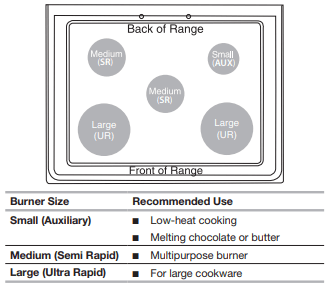
Cookware
IMPORTANT: Do not leave empty cookware on a hot surface cooking area, element or surface burner.
Ideal cookware should have a flat bottom, straight sides and a well-fitting lid, and the material should be of medium-to-heavy thickness.
Rough finishes may scratch the cooktop or coils. Aluminum and copper may be used as a core or base in cookware. However, when used as a base they can leave permanent marks on the surfaces.
Cookware material is a factor in how quickly and evenly heat is transferred, which affects cooking results. A nonstick finish has the same characteristics as its base material. For example, aluminum cookware with a nonstick finish will take on the properties of aluminum.
Cookware with nonstick surfaces should not be used under the broiler.
Check for flatness by placing the straight edge of a ruler across the bottom of the cookware. While you rotate the ruler, no space or light should be visible between it and the cookware.

Use the following chart as a guide for cookware material characteristics.
Aluminum
- Heats quickly and evenly.
- Suitable for all types of cooking.
- Medium or heavy thickness is best for most cooking tasks.
- May leave aluminum residues, which may be diminished if cleaned immediately after cooking.
Cast iron
- Heats slowly and evenly.
- Good for browning and frying.
- Maintains heat for slow cooking.
- Rough edges or burrs may scratch the cooktop.
Ceramic or Ceramic glass
- Follow manufacturer’s instructions.
- Heats slowly, but unevenly.
- Ideal results on low to medium heat settings.
- May scratch the cooktop.
Copper
- Heats very quickly and evenly.
- May leave copper residues, which may be diminished if cleaned immediately after cooking.
- Can leave a permanent stain or bond to the cooktop if overheated.
Earthenware
- Follow manufacturer’s instructions.
- Use on low heat settings.
- May scratch the cooktop.
Porcelain enamel-on steel or cast iron
- See stainless steel or cast iron.
- Porcelain enamel bakeware without the metal base may bond to the cooktop if overheated.
Stainless steel
- Heats quickly, but unevenly.
- A core or base of aluminum or copper on stainless steel provides even heating.
For best results, the cookware should be centered above the burner with the bottom sitting level on the grate. The flame should be adjusted so that it does not extend up the sides of the pan.
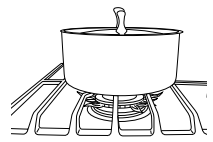
Home Canning
When canning for long periods, alternate the use of surface burners between batches. This allows time for the most recently used areas to cool.
- Center the canner on the grate above the burner.
- Do not place canner on 2 surface burners at the same time.
- For more information, contact your local agricultural extension office, or refer to published home canning guides. Companies that manufacture home canning products can also offer assistance.
OVEN USE
Surface Temperatures
When the range is in use, all range surfaces may become hot, such as the knobs and oven door.
Storage Drawer
When the oven is in use, the drawer may become hot. Do not store plastics, cloth, or other items that could melt or burn in the drawer.
Oven Vent
The oven vent releases hot air and moisture from the oven and should not be blocked or covered. Do not set plastics, paper, or other items that could melt or burn near the oven vent.
Electronic Oven Controls
Control Display
The display will flash when powered up or after a power loss.
Press CANCEL UPPER to clear. When the oven is not in use, the time of day is displayed. If the range is in Energy Save mode, the display will be blank when not in use.
Tones
Tones are audible signals, indicating the following:
One Tone
- Valid keypad press
- Oven is preheated (long tone).
- Function has been entered.
- Reminder, repeating each minute after the end-of-cycle tones
Three Tones
- Invalid keypad press
Four Tones
- End-of-cycle (with a reminder tone every 60 seconds).
Use the Clock/Tools keypad to change the tone settings.
Options
Many features of the oven control can be adjusted to meet your personal needs. These changes are made using the Options keypad.
Use the Options keypad to scroll through the features that can be changed. Each press of the Options keypad will advance the display to the next setting. After selecting the feature to be changed, the control will prompt you for the required input. Details of all of the feature changes are explained in the following sections.
Press OFF to exit Options.
Fahrenheit and Celsius
The temperature is preset to Fahrenheit but can be changed to Celsius.
- Press OPTIONS until “TEMP UNIT” is displayed.
- The current setting will be displayed.
- Press the “1” keypad to adjust the setting.
- Press OFF to save the setting and display the time of day.
Audible Tones Disable
Turns off all tones, including the end-of-cycle tone and keypress tones. Reminder tones are still active when all tones are disabled.
- Press OPTIONS until “SOUND” is displayed.
- The current setting will be displayed.
- Press the “1” keypad to adjust the setting.
- Press OFF to save the setting and display the time of day.
Sound Volume
Sets the volume of the tone to either high or low.
- Press OPTIONS until “SOUND VOLUME” is displayed.
- The current setting will be displayed.
- Press the “1” keypad to adjust the setting.
- Press OFF to save the setting and display the time of day.
End-of-Cycle Tone
Activates or turns off the tones that sound at the end of a cycle.
- Press OPTIONS until “END TONE” is displayed.
- The current setting will be displayed.
- Press the “1” keypad to adjust the setting.
- Press OFF to save the setting and display the time of day.
Keypress Tones
Activates or turns off the tones when a keypad is pressed.
- Press OPTIONS until “KEYPRESS TONE” is displayed.
- The current setting will be displayed.
- Press the “1” keypad to adjust the setting.
- Press OFF to save the setting and display the time of day.
Reminder Tones Disable
Turns off the short repeating tone that sounds every 1 minute after the end-of-cycle tones.
- Press OPTIONS until “REMINDER TONE” is displayed.
- The current setting will be displayed.
- Press the “1” keypad to adjust the setting.
- Press OFF to save the setting and display the time of day.
12/24 Hour Clock
1. Press OPTIONS until “12/24 HOUR” is displayed.
2. The current setting will be displayed.
3. Press the “1” keypad to adjust the setting.
4. Press OFF to save the setting and display the time of day.
Demo Mode
IMPORTANT: This feature is intended for use on the sales floor with 120 V power connection and permits the control features to be demonstrated without the oven turning on. If this feature is activated, the oven will not work.
- Press OPTIONS until “DEMO MODE” is displayed.
- The current setting will be displayed.
- Press the “1” keypad to adjust the setting.
- Press OFF to save the setting and display the time of day.
12-Hour Shutoff
The oven control is set to automatically shut off the oven 12 hours after the oven initiates a cook or clean function. This will not interfere with any timed or delay cook functions.
- Press OPTIONS until “12Hr AUTO_OFF” is displayed.
- The current setting will be displayed.
- Press the “1” keypad to adjust the setting.
- Press OFF to save the setting and display the time of day.
Languages - Scrolling Display Text
Language options are English, Spanish, and French.
- Press OPTIONS until “LANGUAGE” is displayed.
- The current setting will be displayed.
- Press the “1” or “2” keypad to select the desired language.
- Press OFF to save the setting and display the time of day.
Energy Save
The Energy Save mode deactivates the display to reduce energy consumption.
- Press OPTIONS until “ENERGY SAVE” is displayed.
- The current setting will be displayed.
- Press the “1” keypad to adjust the setting.
- Press OFF to save the setting and display the time of day
Oven Temperature Offset Control
IMPORTANT: Do not use a thermometer to measure oven temperature. Elements will cycle on and off as needed to provide consistent temperature but may run slightly hot or cool at any point in time due to this cycling. Most thermometers are slow to react to temperature change and will not provide an accurate reading due to this cycling.
The oven provides accurate temperatures; however, it may cook faster or slower than your previous oven, so the temperature can be adjusted to personalize it for your cooking needs. It can be changed to Fahrenheit or Celsius.
To Adjust Oven Temperature:
1. Press OPTIONS until “TEMP CALIB” is displayed.
2. The current setting will be displayed. Press the “1” keypad to toggle between the oven and the warming drawer
3. Press START to select the choice displayed in Step 2. Wait 10 seconds for the display to change, or press START, and then continue with Step 4.
4. Press the “3” keypad to increase the temperature in 5°F (3°C) increments or press the “6” keypad to decrease the temperature in 5°F (3°C) increments. The offset range is from -30°F to +30°F (-18°C to +18°C).
5. Press OFF to save the setting and display the time of day.
Keep Warm
IMPORTANT: Food must be at serving temperature before placing it in the warmed oven. Food may be held up to 1 hour; however, breads and casseroles may become too dry if left in the oven during the Keep Warm function. For best results, cover food.
The Keep Warm feature allows hot cooked foods to stay at serving temperature.
To Use:
- Press KEEP WARM.
- Press the number keypads to set the desired temperature. If the temperature entered is not in the range of the temperatures allowed, the minimum or maximum allowed temperature will be displayed. Enter a temperature in the allowable range.
- Press START.
- Place food in the oven.
- Press OFF when finished.
- Remove food from the oven.
To Cancel Keep Warm:
Press OFF. Remove food from oven.
Sabbath Mode
The Sabbath mode sets the oven to remain on in a bake setting until turned off.
When the Sabbath mode is set, only the Bake cycle will operate.All other cooking and cleaning cycles are disabled. No tones will sound and the displays will not indicate temperature changes.
When the oven door is opened or closed, the oven light will not turn on or off and the heating elements will not turn on or off immediately.
To Enable Sabbath Mode Capability (One Time Only):
- Press OPTIONS until “SABBATH” is displayed.
- Press the “1” keypad. “ON. Press (1) for Off” will scroll in the display. Sabbath mode can be activated for baking.
- Press START or OFF to exit and display the time of day.
NOTE: To disable the Sabbath mode, repeat steps 1 through 3 to change the status from “SABBATH ON” to “SABBATH OFF.”
To Activate Sabbath Mode:
- Press BAKE for the desired oven.
- Press the number keypad to set a temperature other than 350°F (177°C).
- Press START. For timed cooking in Sabbath mode, press COOK TIME and then the number keypads to set the desired cook time.
- Press OPTIONS. Three tones will sound. Then press “7.” “SAb” will appear in the display.
To Adjust Temperature (When Sabbath Mode Is Running):
- Press BAKE.
- Press the number keypad as instructed by the scrolling text to select the new temperature. NOTE: The temperature adjustment will not appear on the display, and no tones will sound. The scrolling text will be shown on the display as it was before the keypad was pressed.
- Press START
To Deactivate Sabbath Mode:
Press OPTIONS, and then press “7” to return to regular baking, or press OFF for the desired oven to turn off the range.
NOTE: No tones will sound while deactivating Sabbath mode.
Aluminum Foil
IMPORTANT: To avoid permanent damage to the oven bottom finish, do not line the oven bottom with any type of foil or liner.
For best cooking results, do not cover entire oven rack with foil because air must be able to move freely.
Positioning Racks and Bakeware
IMPORTANT: To avoid permanent damage to the porcelain finish, do not place food or bakeware directly on the oven door or bottom.
Bakeware
To cook food evenly, hot air must be able to circulate. Allow 2" (5cm) of space around bakeware and oven walls. Make sure that no bakeware piece is directly over another.
Racks
- Position racks before turning on the oven.
- Do not position racks with bakeware on them.
- Make sure racks are level.
To position a rack, pull it out to the stop position, raise the front edge, and then lift out. Use the following illustration and charts as guides.

The oven has 7 positions for a flat rack, as shown in the previous illustration and the following table.
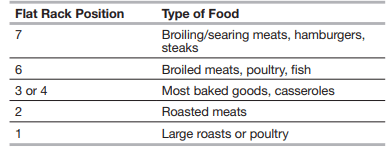
For hamburger patties to have a well-seared exterior and a rare interior, use a flat rack in rack position 7. Side 1 should cook for approximately 21 to 31 minutes. Side 2 should cook for approximately 4 to 5 minutes. Expect a moderate degree of smoke when broiling.
If your model has a Max Capacity Oven Rack, the recessed ends must be placed in the rack position above the desired position of the food. See the following illustration.
IMPORTANT: These rack positions are for flat racks. If a Max Capacity Oven Rack is used, the rack position must be adjusted as shown in the previous figure.

Multiple Rack Cooking
2-rack (non-convection): Use rack positions 2 and 5 or 3 and 6.
2-rack (convection): Use rack positions 2 and 5 or 3 and 6.
3-rack (convection): Use a flat rack in rack positions 4 and 6 and a Max Capacity Oven Rack in rack position 3.
Baking Layer Cakes
For best results when baking cakes on 2 racks, use the Bake function, a flat rack in rack position 3 and a roll-out rack in rack position 5. Place the cakes on the racks as shown. Keep at least 3" (7.6 cm) of space between the front of the racks and the front cakes.

Baking Cookies
For best results when baking cookies on 2 racks, use the Convection Bake function, a flat rack in rack position 3 and a roll-out rack in rack position 4.
Oven Vent
The oven vent releases hot air and moisture from the oven and should not be blocked or covered. Blocking or covering the vent will cause poor air circulation, affecting cooking and cleaning results. Do not set plastics, paper, or other items that could melt or burn near the oven vent.

Baking and Roasting
Preheating
When beginning a Bake, Convect Bake, or Convect Roast cycle, the oven will begin preheating after Start is pressed. The oven will take approximately 12 to 15 minutes to reach 350°F (177°C) with all of the oven racks provided with your oven inside the oven cavity. Higher temperatures will take longer to preheat. The preheat cycle rapidly increases the oven temperature. The actual oven temperature will go above your set temperature to offset the heat lost when your oven door is opened to insert food. This ensures that when you place your food in the oven, the oven will begin at the proper temperature. Insert your food when the preheat tone sounds. Do not open the door during preheat before the tone sounds.
Oven Temperature
While in use, the oven elements will cycle on and off as needed to maintain a consistent temperature, but they may run slightly hot or cool at any point in time due to this cycling. Opening the oven door while in use will release the hot air and cool the oven which could impact the cooking time and performance. It is recommended to use the oven light to monitor cooking progress.
NOTE: On models with convection, the convection fan may run in the non-convection Bake mode to improve oven performance.
Temperature Management System
The Temperature Management System electronically regulates the oven heat levels during preheat and Bake to maintain a precise temperature range for optimal cooking results. The bake and broil elements or burners cycle on and off in intervals. On convection range models, the fan will run while preheating and may be cycled on and off for short intervals during Bake to provide the best results. This feature is automatically activated when the oven is in use.
Before baking and roasting, position racks according to the “Positioning Racks and Bakeware” section. When roasting, it is not necessary to wait for the oven preheat cycle to end before putting food in, unless it is recommended in the recipe.
Broiling
No preheating is necessary, unless recommended otherwise in the recipe. Position food on grid in a broiler pan, and then place it in the center of the oven rack.
IMPORTANT: Close the door to ensure proper broiling temperature.
Changing the temperature when broiling allows more precise control when cooking. The lower the broil setting is, the slower the cooking. Thicker cuts and unevenly shaped pieces of meat, fish, and poultry may cook better at lower broil settings. Use rack 6 or 7 for broiling. Refer to the “Positioning Racks and Bakeware” section for more information.
- For best results, use a broiler pan and grid. It is designed to drain juices and help avoid spatter and smoke.If you would like to purchase a broiler pan, one may be ordered. See the “Accessories” section.
Convection Cooking
In a convection oven, the fan-circulated hot air continually distributes heat more evenly than the natural movement of air in a standard thermal oven. This movement of hot air helps maintain a consistent temperature throughout the oven, cooking foods more evenly, crisping surfaces while sealing in moisture and yielding crustier breads.

During convection baking or roasting, the bake, broil, and convection elements cycle on and off in intervals while the fan circulates the hot air. During convection broiling, the broil and convection elements cycle on and off.
If the oven door is opened during convection cooking, the fan will turn off immediately. It will come back on when the oven door is closed.
Position the racks according to the “Positioning Racks and Bakeware” section before starting convection cooking. With convection cooking, most foods can be cooked at a lower temperature or at a shorter time. These adjustments can be made using the following chart or by using the EasyConvect™ Conversion feature on your range.

Bow Tie True Convection with T.H.E.™ Element
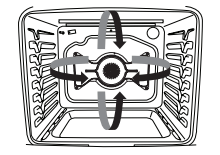
True convection adds an electric element around the convection fan to enhance the cooking performance. This feature enables three-rack baking in your range. Use the following Convect Options chart as a guide.
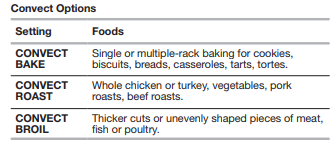
EasyConvect™ Conversion
Convection cooking temperatures and times can differ from those of standard cooking. Depending upon the selected category, EasyConvect™ conversion automatically reduces the standard recipe temperature and/or time you input for convection cooking.
Foods are grouped into 4 general categories. Choose the category most appropriate for the food to be cooked. Use the following chart as a guide.
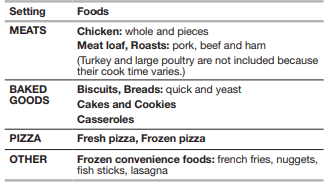
To Use:
NOTE: For best results, preheat your oven to the desired temperature prior to using Easy Convect™ Conversion. After preheating is complete, press OFF before using EasyConvect™ Conversion.
- Press the EASY CONVECT key for the desired option (MEATS, BAKED GOODS, PIZZA or OTHER).
- Press START.
- Press the number keys to enter standard cook temperature, and then press START.
- Press the number keys to enter standard cook time, and then press START.
- Place the food in the oven. Check food for doneness before the stop time is reached. If food will not be done when the stop time is reached, add more cooking time before time elapses (see the “Cook Time” section). At the end of the stop time, the oven will automatically turn off.
- Press OFF when finished.
- Remove food from the oven.
Proofing Bread
Proofing bread prepares the dough for baking by activating the yeast. Follow the recipe directions as a guide. Proof should be used for fresh dough, thawed dough, and for the first and second rise.
To Proof:
Before first proofing, place the dough in a lightly greased bowl and cover loosely with wax paper, coated with shortening. Place on rack guide 2 and close the oven door.
- Press BREAD PROOF until the desired proof is displayed (“Standrd” or “Rapid”).
- Press START.
- Press OFF when finished proofing.
Before second proofing, shape the dough, place it in baking pan(s), and cover loosely. Follow the same placement and control steps above. Before baking, remove the cover.
NOTE: If the oven temperature is greater than 120°F (49°C), the display will indicate “Oven Cooling” until the temperature is below 120°F (49°C).
Cook Time

To Set a Timed Cook:
- Press BAKE, CONVECT BAKE, CONVECT ROAST or CONVECT BROIL.
- Press the number keypads to set the desired temperature. If the temperature entered is not in the range of the temperatures allowed, the minimum or maximum allowed temperature will be displayed. Enter a temperature in the allowable range.
- Press COOK TIME.
- Press the number keypads to enter the length of time to cook.
- Press START. The display will count down the time. When the time ends, the oven will shut off automatically. The temperature and/or time setting can be changed at any time by repeating steps 2 through 5.
- Press OFF to clear the display.
NOTE: The time setting for any timed cooking function, including EasyConvect™ Conversion, can be adjusted by following the previous steps 3 through 5.
To Set a Delayed Timed Cook:
- Press DELAY START.
- Press the number keypads to enter the number of hours and/ or minutes you want to delay the start time.
- Press BAKE, CONVECT BAKE, CONVECT ROAST or CONVECT BROIL.
- Press the number keypads to set the desired temperature. If the temperature entered is not in the range of the temperatures allowed, the minimum or maximum allowed temperature will be displayed. Enter a temperature in the allowable range.
- Press START or COOK TIME.
- Press number keypads to enter the length of time to cook.
- Press START. When the start time is reached, the oven will automatically turn on. The temperature and/or time settings can be changed after the delay countdown by repeating steps 1 through 7. When resetting the time and temperature, it is necessary to press Start between steps 4 and 5 to continue making changes. When the set cook time ends, the oven will shut off automatically.
- Press OFF to clear the display
RANGE CARE
Clean Cycle
AquaLift® Technology is an innovative cleaning solution that utilizes heat and water to release baked-on spills from the oven in less than 1 hour. This new cleaning technology is a low-heat, odor-free alternative to traditional self-cleaning options.
Allow the oven to cool to room temperature before using the Clean cycle. If your oven cavity is above 200°F (93°C), “Oven Cooling” will appear in the display and the Clean cycle will not be activated until the oven cavity cools down.
To Clean:
1. Remove all racks and accessories from the oven cavity and wipe excess soil. Use a plastic scraper to remove easily removed soils.

2. Pour 2 cups (16 oz [500 mL]) of distilled or filtered water onto the bottom of the empty oven and close the oven door.

IMPORTANT: Do not use chemicals or other additives with the water. Do not open the oven door during the Clean cycle. The water on the oven bottom is hot.
3. Press AQUALIFT SELF CLEAN and then START on the oven control panel.
4. Allow 40 minutes for cleaning and cooldown. A beep will sound when the Self-Cleaning cycle is complete.
5. Press OFF at the end of the cycle. Cancel Upper may be pressed at any time to stop the Clean cycle.
6. Remove the residual water and loosened soils with a sponge or cloth immediately after the Clean cycle is complete. Much of the initial 2 cups (16 oz [500 mL])of water will remain in the oven after the cycle is completed. If additional soils remain, leave a small amount of water in the oven bottom to assist with the cleaning.

7. If any soils remain, remove them with a non-scratch scrubbing sponge or plastic scraper. Additional Clean cycles may be run to help remove the stubborn soils.
IMPORTANT: Do not use oven cleaners. The use of chemicals, including commercial oven cleaners or metal scouring pads, may cause permanent damage to the porcelain surface of the oven interior.
NOTES:
- The range should be level to ensure that the entire surface of the bottom of the oven cavity is covered by water at the beginning of the Clean cycle.
- For best results, use distilled or filtered water. Tap water may leave mineral deposits on the oven bottom.
- Before removing the residual water and loosened soils at the end of the Clean cycle, insert a cloth or paper towel between the lower edge of the oven door and the front frame to keep water from spilling onto the front of the range and the floor.
- Soil baked on through several cooking cycles will be more difficult to remove with the Clean cycle.
- Nonabrasive scrub sponges or eraser-style cleaning pads (without cleaners) can be effective for cleaning the oven cavity walls, oven door, and oven bottom for difficult soils. For best results, moisten the pads and sponges before use.
- Run an additional Clean cycle for stubborn soils.
- affresh® Kitchen Appliance Cleaner and affresh® Cooktop Cleaner may be used to clean the oven bottom, walls, and door when the oven has finished the cycle and returned to room temperature. If affresh® Cooktop Cleaner is used, it is recommended to wipe out the cavity with distilled water as well. Refer to the “Accessories” section for information on ordering.
- Additional AquaLift® Technology Cleaning Kits may be obtained by ordering Part Number W10423113RP. See the “Accessories” section for more information.
- For assistance with AquaLift® Technology, call 1-877-258-0808 in the U.S.A. or 1-800-807-6777 in Canada, or visit our website
General Cleaning
IMPORTANT: Before cleaning, make sure all controls are OFF and the oven and cooktop are cool. Always follow label instructions on cleaning products.
Soap, water, and a soft cloth or sponge are suggested first, unless otherwise noted.
EXTERIOR PORCELAIN ENAMEL SURFACES on some models)
Food spills containing acids, such as vinegar and tomato, should be cleaned as soon as the entire range is cool. These spills may affect the finish.
Cleaning Method:
- Glass cleaner, mild liquid cleaner, or nonabrasive scrubbing pad:
Gently clean around the model/serial/rating plate because scrubbing may remove numbers.
- Affresh® Kitchen and Appliance Cleaner Part Number W10355010 (not included): See the “Accessories” section for more information.
STAINLESS STEEL (on some models)
NOTE: To avoid damage to stainless steel surfaces, do not use soap-filled scouring pads, abrasive cleaners, Cooktop Cleaner, steel-wool pads, gritty washcloths or abrasive paper towels.
Damage may occur to stainless steel surfaces, even with one-time or limited use.
Cleaning Method:
Rub in direction of grain to avoid damaging.
- affresh® Stainless Steel Cleaner Part Number W10355016 (not included): See the “Accessories” section for more information.
METALLIC PAINT (on some models)
Do not use abrasive cleaners, cleaners with bleach, rust removers, ammonia or sodium hydroxide (lye) because paint surface may stain.
PORCELAIN-COATED GRATES AND CAPS
Food spills containing acids, such as vinegar and tomato, should be cleaned as soon as the cooktop, grates and caps are cool. These spills may affect the finish.
To avoid chipping, do not bang grates and caps against each other or hard surfaces such as cast iron cookware.
Do not reassemble caps on burners while wet.
Cleaning Method:
- Nonabrasive plastic scrubbing pad and mildly abrasive cleanser:
Clean as soon as cooktop, grates and caps are cool.
- Dishwasher (grates only, not caps):
Use the most aggressive cycle. Cooked-on soils should be soaked or scrubbed before going into a dishwasher.
- Gas Grate and Drip Pan Cleaner Part Number 31617 (not included): See the “Accessories” section for more information.
SURFACE BURNERS
Food spills containing acids, such as vinegar and tomato, should be cleaned as soon as the cooktop, grates and caps are cool. These spills may affect the finish.
To avoid chipping, do not bang grates and caps against each other or hard surfaces such as cast iron cookware.
Do not reassemble caps on burners while wet.
Do not clean in the Self-Cleaning cycle.
Do not clean in dishwasher.
Cleaning Method:
- Nonabrasive plastic scrubbing pad and mildly abrasive cleanser: Clean as soon as cooktop, grates, burners and caps are cool.
- Gas Grate and Drip Pan Cleaner (not included).
COOKTOP CONTROLS
To avoid damage to the cooktop controls, do not use steel wool, abrasive cleansers or oven cleaner.
To avoid damage, do not soak knobs. When replacing knobs, make sure knobs are in the Off position.
On some models, do not remove seals under knobs.
Cleaning Method:
- Soap and water: Pull knobs straight away from control panel to remove.
GRIDDLE
To avoid damaging the nonstick surface, do not use steel wool or abrasive cleaners.
Cleaning Method:
- Mild detergent
CONTROL PANEL AND OVEN DOOR EXTERIOR
To avoid damage to the control panel, do not use abrasive cleaners, steel-wool pads, gritty washcloths or abrasive paper towels.
Cleaning Method:
- Glass cleaner and soft cloth or sponge: Apply glass cleaner to soft cloth or sponge, not directly on panel.
- affresh® Kitchen and Appliance Cleaner Part Number W10355010 (not included): See the “Accessories” section for more information.
OVEN RACKS
Cleaning Method:
- Steel-wool pad.
- For racks that have discolored and are harder to slide, a light coating of vegetable oil applied to the rack guides will help them slide.
- Dishwasher (steam rack water reservoir only, not racks):
Although the water reservoir is durable, it may lose its shine and/or discolor when washed in a dishwasher.
STORAGE DRAWER OR WARMING DRAWER (on some models)
Check that storage or warming drawer is cool and empty before cleaning.
Cleaning Method:
- Mild detergent.
OVEN CAVITY
Use AquaLift® Technology regularly to clean oven spills.
Do not use oven cleaners.
Food spills should be cleaned when oven cools. At high temperatures, foods react with porcelain and staining, etching,pitting or faint white spots can result.
Cleaning Method:
- Clean cycle:
See “Clean Cycle” section.
TROUBLESHOOTING
Nothing will operate
- Power supply cord is unplugged - Plug into a grounded outlet.
- ENERGY SAVE is active, and the display is blank - Press any keypad on the control to display the time of day. See the “Electronic Oven Controls” section for more information.
- Household fuse is blown or a circuit breaker is tripped - Replace the fuse or reset the circuit breaker. If the problem continues, call an electrician.
- The control displays an F9 or F9 E0 error code - The electrical outlet in the home may be miswired. Contact a qualified electrician to verify the electrical supply.
Surface burners will not operate
- The control knob is not set correctly - Push in knob before turning to a setting.
- Air in the gas lines - If this is the first time the surface burners have been used, turn on any one of the surface burner knobs to release air from the gas lines.
- Clogged burner ports - See the “Sealed Surface Burners” section.
Surface burner flames are uneven, yellow and/ or noisy
- Clogged burner ports - See the “Sealed Surface Burners” section.
- Burner caps positioned improperly - See the “Sealed Surface Burners” section.
- Range converted improperly - If propane gas is being used, contact a service technician or see the “Warranty” section for contact information.
Excessive heat around cookware on cooktop
- Cookware and flame are not matched - The cookware should be centered above the burner with the bottom sitting level on the grate. The flame should be adjusted so that it does not extend up the sides of the pan.
Cooktop cooking results not what expected
- Improper cookware - Ideal cookware should have a flat bottom, straight sides and a well fitting lid, and the material should be of a medium to heavy thickness.
- Control knob set to incorrect heat level - See the “Cooktop Use” section.
- Range is not level - Level the range. See the Installation Instructions.
Oven will not operate
- Delay Start is set - See the “Cook Time” section.
- Control is locked - Press and hold START for 3 seconds to unlock.
- The range is in Demo mode - Demo mode will deactivate all oven elements. See “Demo Mode” in the “Electronic Oven Controls” section.
- Electronic oven control set incorrectly - See the “Electronic Oven Controls” section.
Oven temperature too high or too low
- Oven temperature needs adjustment - See “Oven Temperature Control” in the “Electronic Oven Controls” section.
Display shows messages
- Power failure (display shows flashing time) - Clear the display. On some models, reset the clock, if needed. See “Clock” keypad feature in the “Feature Guide” section.
- Error code (display shows letter followed by number) - Depending on your model, press CANCEL to clear the display. See “Control Display” in the “Electronic Oven Controls” section. If it reappears, call for service. See the “Warranty” section for contact information.
- Start needs to be pressed so a cycle can begin (display shows “PUSH” or “PSH”) - See the “Start” keypad feature in the “Feature Guide” section.
- Range is in Sabbath mode (display shows “SAb”) - Press CANCEL to exit Sabbath mode.
Clean cycle did not work on all spills
- Several cooking cycles between Clean cycles or spills on oven walls and doors - Run additional Clean cycles. Use the AquaLift® Technology Cleaning Kit. affresh® Kitchen and Appliance Cleaner or affresh® Cooktop Cleaner can be used for stubborn soils. See the “Accessories” and “Clean Cycle” sections for more information.
Mineral deposits are left on the oven bottom after the Clean cycle
- Tap water was used in the Clean cycle - Use distilled or filtered water in the Clean cycle. To remove deposits, use a cloth soaked with vinegar. Then use a cloth dampened with water to thoroughly remove any vinegar residue.
- Range is not level - Mineral deposits will collect on dry areas of the oven bottom during the Clean cycle. Level the range. See the Installation Instructions. To remove deposits, use a cloth soaked with vinegar. Then use a cloth dampened with water to thoroughly remove any vinegar residue.
Oven cooking results not what expected
- Range is not level - Level the range. See the Installation Instructions.
- The set temperature was incorrect - Double-check the recipe in a reliable cookbook.
- Oven temperature needs adjustment - See “Oven Temperature Control” in the “Electronic Oven Controls” section.
- Oven was not preheated - See the “Baking and Roasting” section.
- Racks were positioned improperly - See the “Positioning Racks and Bakeware” section.
- Not enough air circulation around bakeware - See the “Positioning Racks and Bakeware” section.
- Darker browning of food caused by dull or dark bakeware - Lower oven temperature 25°F (15°C) or move rack to a higher position in the oven.
- Lighter browning of food caused by shiny or light colored bakeware - Move rack to a lower position in the oven.
- Batter distributed unevenly in pan - Check that batter is level in the pan.
- Incorrect length of cooking time was used - Adjust cooking time.
- Oven door was not closed - Be sure that the bakeware does not keep the door from closing.
- Oven door was opened during cooking - Oven peeking releases oven heat and can result in longer cooking times.
- Rack is too close to bake burner, making baked items too brown on bottom - Move rack to higher position in the oven.
- Pie crusts browning too quickly - Use aluminum foil to cover the edge of the crust and/or reduce baking temperature.
Noises
Surface burner making popping noises
- Wet burner - Allow it to dry.
Gas range noises during Bake and Broil operations The following are some normal sounds with the explanations.
- These sounds are normal operational noises that can be heard each time the Bake or Broil burners ignite during the cycle.
Pop
- Gas valve is opening or cycling on and will make a single pop when it snaps open from the solenoid. It sounds similar to a suction cup being pulled off of a piece of glass – This is normal.
Click
- The igniters will click several times until the flame is detected. These are short clicking sounds like tapping a nail onto a piece of glass – This is normal. Convection fan relay is cycling on and off (on some models) – This is normal.
Woosh or poof
- Bake or Broil burner is igniting – This is normal.
Oven burner flames are yellow or noisy
- Range converted improperly – If propane gas is being used, contact a service technician or see the “Warranty” section for contact information.
See other models: YMEDC400VW WRX988SIBB XCAE2765FQ GB2SHDXTB YWML55011HW
